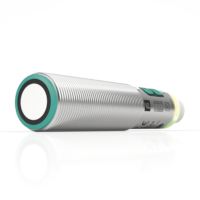Measuring the Roller Diameter Accurately in Battery Cell Production
Robust Ultrasonic Sensor Reliably Detects All Materials

The Application
The foils for the anode, cathode, and separator are basic materials in battery cells. They are wound on rolls and then joined together using a calendering process. This is a high-speed and start/stop operation that requires precise interaction between each component. For an efficient process with minimal machine downtime, used rolls must be changed at precisely the right time. A key factor here is material consumption; the diameter of the roll shrinks during unwinding. Being able to accurately measure the diameter of the rolls makes it easier to ensure they are changed at the optimal time.
The Goal
The material on the roll varies in color. It is very dark in places, but can also have reflective sections. The roll diameter must be measured reliably and with high accuracy, regardless of these optical properties. Detection must also be unaffected by the metal surfaces in the machine. Conversely, the sensor technology used must not cause EMC interference. To prevent damage to the material and wear on the sensor, detection should be noncontact.
The Solution

UC18GS Ultrasonic Sensor
Ultrasonic sensors detect the target object regardless of its optical properties. Their design makes them resistant to contamination and adverse ambient conditions. They do not generate EMC interference; the sensing mode is not affected by electromagnetic interference. In addition to the F42 series, the UC18GS series is especially well suited for continuously measuring roll diameters. They combine state-of-the-art ultrasonic technology with the option of IO-Link communication. This makes them very easy to parameterize and able to provide additional data for integrated diagnostics and process optimization alongside the high-precision measurement data.
Technical Features
- Extremely small dead band
- IO-Link interface
- Temperature range: -25 °C to +70 °C
- Programming and parameterization via push button, IrDA, or IO-Link interface
- Teach-in
- Degree of protection (IP67)
- Automatic synchronization when using multiple sensors
The Benefits
These compact sensors can also be used in confined spaces. An especially small dead band of 30 mm and a detection range of 500 mm mean that the sensor can be mounted in a wide variety of locations. The diameter of the sound cone can be adapted to the application. Automatic synchronization means up to ten sensors can be used simultaneously in a confined space without any interference—or parameterization effort. In addition to IO-Link, the sensors are equipped with an infrared interface (IrDA) and conventional push buttons for programming purposes: The latter can be used for configuration directly at the sensor.
At a Glance
- Provides reliable measurements that do not depend on the optical characteristics of the material
- Noncontact detection prevents wear and protects material
- Resistant to dirt, interference, and harsh environments
- IO-Link communication for simple parameterization, integrated diagnostics, and process optimization
- Multiple sensors can be used in a small space with no cross-talk









 +44 161 6336431
+44 161 6336431